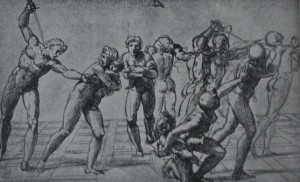Artists speak a lot about “form”. In my day in the sculpture school at Camberwell we were ever conscious that our job was to see form. In three or four years of study I guess 50% of us made it. The rest were given to understand that they needed to find some less demanding occupation (such as Art History). Form was just the beginning, the next step was to see forms adding up to a united structure – the hope was that the forms were so harmoniously united the work became a composition.
Many books on drawing describe form. Raphael is a master of form. In its simplest sense, form consists of those geometrical shapes one might make on a lathe; cones, cylinders or eggs; also blocks or other rectilinear shapes. Durer made a number of demonstrations of figures seen as a series of forms. The artists’ lay-figure is another demonstration of the use of forms which is the clear basis of Raphael’s drawing from imagination, in fact most artists construct drawings in this way. (I would recommend G.B.Bridgman’s Drawing from Life, to those who wish to pursue this idea of form.)
It is a schema that was heavily relied upon during the Renaissance even when drawing from life. It had the negative result of making renaissance drawings a bit clonelike. As a schoolboy I regarded this likeness as necessary to drawing. I rather imagine that most people today are only satisfied that someone “can really draw” when they recognise that likeness in a work. Another common expectation is anatomy, also a renaissance obsession. I do not use the word “form” to mean anatomy, though some do; nor is it just meat. I use the word to denote that more abstract mental concept, which I (and Plato) have described.

Raphael's Massacre of the Innocents
If we then add to the lay-figure concept the idea of perspective we have defined renaissance syntax. It was a great success up to a point but Rembrandt, probably subconsciously, realized that to express the feelings of his protagonists it was inadiquate. He needed to convey a much more precise sense of the space occupied by his actors in order to “give maximum expression to feeling”. This necessitated a new syntax, of which the “experts” seem oblivious.
A visual demonstration of Rembrandt’s new syntax will be coming shortly on this blog as I cannot point to other sources nor explain it without diagrams.